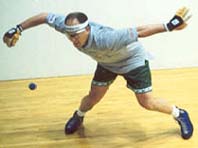 handball has a thriving international dimension,
being played in the United States, Canada, Australia, Mexico, Spain and
other parts of Europe. World and European championships are now staged.
handball has a thriving international dimension,
being played in the United States, Canada, Australia, Mexico, Spain and
other parts of Europe. World and European championships are now staged.
History and Background
Over
the centuries the game was played in outdoor ball alleys (in the early
days it was often played with just a single wall) but it has now become
more sophisticated and moved indoors. Competition for both sexes and all
age groups now take place in plush, enclosed handball courts, making the
game faster than ever and certainly more exciting and entertaining.
Uniquely
among Irish Gaelic Games,  handball has a thriving international dimension,
being played in the United States, Canada, Australia, Mexico, Spain and
other parts of Europe. World and European championships are now staged.
handball has a thriving international dimension,
being played in the United States, Canada, Australia, Mexico, Spain and
other parts of Europe. World and European championships are now staged.
It is thought that Irish emigrants introduced the game to the United States and also to Australia, probably in the nineteenth century. US Army personnel were responsible for bringing the game to mainland Europe. Wherever the game is played throughout the world, the various versions are all thought to be linked to the traditional Irish game, with the possible exception of "Fives", a game played in the United Kingdom and "Pelota", a game similar to handball which is played in Spain.
The
object of the game is to win each rally (exchange of shots) by serving
or returning the ball so your opponent is unable to keep the ball in play.
The ball is struck with the palm of the hand, or sometimes with a closed
fist. When a player has twenty-one points, they have won the game and the
player who is first to win two games is declared the winner of the match.
The duration of games therefore varies. A referee officiates at all competitive
games.
Traditionally
the Irish played with the hardball in open courts. The hardball is about
two inches in diameter, weights about one a half ounces, has a rubber centre
and is bound with leather. The courts evolved into the present 60 x 30
feet venues where hardball continues. Later the softball was introduced
(this ball is about 2.2 inches in diameter, is made of rubber and weights
about 62 grams) and this version of the game was played alongside the old
hardball game.
The 40 x 20 game was introduced into Ireland in the early 1970s, and a feature of this game is the use of the ceiling, making it in effect a five-wall game. At the present time there are three handball codes played in Ireland, the traditional Irish game of 60 x 30 (hardball), softball (played in a 60 x 30 court) and 40 x 20 (the International game). Irish players have acquitted themselves well in international competition, winning many World and US titles at various levels.
Handball had an international dimension as far back as one hundred and fifty years ago, making it the true pioneering game of the G.A.A. Towards the end of the nineteenth century a form of world championships were already being held by the enterprising stars of the day. Top players would often challenge one another for prize money. In 1923 the G.A.A. set about establishing Provincial Handball Councils in Ireland. The Irish Handball Council was established the following year and was allowed to govern the game independently, although it remains a part of the G.A.A. structure.
One of handball's great appeals is that it can be played to middle age and beyond. Many middle-aged or elderly people use it as a pastime and as a way to stay fit and healthy. Competitions for the most energetically minded mature adults are now played annually in Ireland.
Today, boosted by modern facilities, better organisation, increased media interest and its international dimension, handball is a very competitive sport in Ireland. The magnificent new indoor facilities, in which all competitions now take place, has attracted more players, male and female, and the game is in a very healthy state. The simple technique of making the back wall in the enclosed courts a see-through one with a glass panel has proven to be a great success, attracting spectators who can sit in comfort in sports centres, watching competitors in action.
Over
the years handball has endured many difficulties and challenges. The fact
that it has survived and prospered is testimony to the many players and
administrators who supported the game. Its future as a national and international
game is well secure.